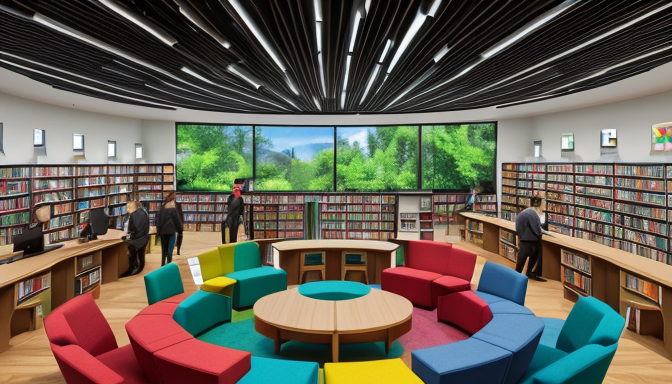The journey of libraries has been nothing short of extraordinary. Once upon a time, these sanctuaries of knowledge were filled with dusty shelves and the scent of aged paper. Today, they have transformed into vibrant, dynamically evolving spaces that cater to the needs of a digital-savvy society. Imagine walking into a library where the traditional silence is replaced by the soft hum of technology, where patrons are not just readers but active participants in their learning journey.
In the past, libraries were primarily seen as repositories of books, where the only interaction was with a librarian who would help you find your next read. Now, they are becoming multi-faceted community hubs. With the integration of technology, libraries offer a plethora of resources, from e-books and audiobooks to online databases and interactive workshops. This shift has not only made information more accessible but has also transformed libraries into places where people can gather, learn, and collaborate.
As we look to the future, one can’t help but wonder: what will libraries evolve into next? Will they become even more integrated into our daily lives, or will they face challenges that could threaten their existence? The answer lies in their ability to adapt and innovate, ensuring they remain relevant in an ever-changing digital landscape. The library of tomorrow is not just a place to borrow books; it’s a gateway to knowledge, a center for community engagement, and a facilitator of lifelong learning.
The Role of Technology in Modern Libraries
Technology has truly revolutionized the way libraries function, transforming them from quiet, dusty repositories of books into vibrant, interactive spaces that cater to the diverse needs of their communities. Imagine walking into a library where instead of just rows of books, you find digital kiosks, virtual reality stations, and even 3D printers! This is not science fiction; it’s the new reality of modern libraries.
One of the most significant advancements is the introduction of digital collections. Patrons can now access thousands of e-books, audiobooks, and online journals from the comfort of their homes. This means that the library’s resources are no longer confined to its physical walls. With just a few clicks, users can dive into a sea of information, making learning and research incredibly accessible.
Moreover, libraries are leveraging technology to enhance user experience. For instance, many libraries offer online services such as e-reservation systems for books, virtual reference services, and even online workshops. These services not only save time but also make it easier for individuals to engage with library resources. Have you ever wondered how a simple app can bring the library to your pocket? It’s all about embracing technology!
In conclusion, as we look at the role of technology in modern libraries, it’s clear that these institutions are not just surviving; they are thriving. They are becoming community hubs where technology meets tradition, ensuring that everyone has the opportunity to learn and grow in a digital world.

The Future of Libraries in the Digital Age
The future of libraries is a thrilling journey into the digital realm, where the traditional concept of a library is evolving faster than ever. Imagine walking into a space that feels less like a dusty archive and more like a vibrant community hub! Libraries are not just about books anymore; they are transforming into dynamic learning environments equipped with technology that meets the needs of today’s digital-savvy patrons.
As we look ahead, libraries are embracing their role as community centers. They are becoming places where people can gather to learn new skills, attend workshops, and access technology that might otherwise be out of reach. For instance, many libraries are now offering 3D printing services, coding classes, and even virtual reality experiences that allow users to explore new worlds without leaving their seats. This shift is akin to transforming a quiet reading room into a bustling innovation lab!
Moreover, libraries are increasingly focusing on collaboration with local organizations, schools, and businesses. This collaboration ensures that they remain relevant in a fast-paced digital world. By providing access to online resources, e-books, and databases, libraries are ensuring that everyone, regardless of their background, has the opportunity to thrive in the digital age.
In summary, the future of libraries is bright and full of possibilities. They are evolving into multifunctional spaces that not only preserve knowledge but also foster community engagement and innovation. So, the next time you think of a library, remember: it’s not just a place for books; it’s a gateway to the future!
Frequently Asked Questions
- What is the primary role of modern libraries?
Modern libraries serve as more than just book repositories; they are vibrant community hubs that offer a range of services, including digital collections, workshops, and access to technology.
- How has technology changed the library experience?
Technology has transformed libraries by providing online access to resources, enabling virtual programs, and enhancing user interaction through apps and digital tools, making information more accessible than ever.
- Will libraries still be relevant in the digital age?
Absolutely! Libraries are evolving to meet the needs of their communities, acting as learning centers and technology facilitators, ensuring they remain essential in our increasingly digital world.
- Can I access library resources online?
Yes! Many libraries offer extensive online databases, e-books, and virtual services, allowing you to access resources from the comfort of your home.
- What types of programs do libraries offer today?
Today’s libraries host a variety of programs, including tech workshops, book clubs, children’s storytime, and community events, catering to diverse interests and age groups.